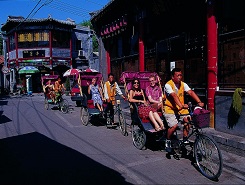BEIJING HUTONG TOUR
|
Tour ItineraryTour Price Which including: Tour Cost per person: |
|
Details:
The Hutong is an ancient city alley in Beijing, where hutongs run into the several thousand. Surrounding the Forbidden City, many were built during the Yuan, Ming and Qing dynasties. In the prime of these dynasties the emperors, in order to establish supreme power for themselves, planned the city and organized the living areas according to the etiquette systems of the Zhou Dynasty. The center of the city of Beijing was the Forbidden City.The hutong actually symbolized to the regular hutong, was near the palace to every direction and put in orderly along the streets. Most of the residents of these hutongs were imperial aristocrats. furthermore, the simple hutong was located to the north and south of the palace. The residents were merchants and other common people.

The big buildings in the hutong were almost all quadrangles–a building complex formed by four houses around a courtyard . The quadrangles varied in size and design according to the social status of the residents. The big quadrangles of high- ranking officials and wealthy merchants were built with roof beams and pillars all carved and painted, each with a front and back yard. However, all of the common people’s quadrangles were simply built with small gates and houses. Hutongs are passageways linked by many arranged quadrangles of different sizes. The specially built quadrangles all face the south for better lighting; as a result, a lot of hutongs run from east to west. Between the big hutongs many small ones went north and south for convenient passage.
At the end of the Qing Dynasty unified and closed China came under influence from abroad,The stereotyped arrangement of the hutong was also affected. Many newly formed hutongs with irregular houses appeared outside the city, while many old ones lost their former neat arrangement. The social status of the residents also changed, reflecting the collapse of the feudal system. During the period of the Republic of China , Chinese society was unstable, with civil wars and repeated foreign invasions. After the founding of the people’s Republic of China in 1949,the houses in many hutongs have been pulled down and replaced by modern buildings.The hutong today is fading into the shade for both tourists and inhabitants.

However, in the urban district of Beijing houses along hutongs still occupy one third of the total area, providing housing for half the population, so many hutongs have lived.and we see the old in the new in Beijing as an ancient yet modern city. Showed as early as hundreds of years ago, narrow lanes, or hutongs were in ancient Beijing. In the past, several thousand lanes, alleys and quadrangles linked living areas for people living in the capital. Today,as the city turned into an international mcity, its lanes and alleyways, occupying one third of the city proper, still serve as houses for half the total urban population.
If sightseeing at the Imperial Palace, Ming Tombs and the Summer Palace is helpful in experiencing about the lives of emperors, the hutongs of Beijing reflect in turn the history of Beijing as a whole.A day tour through hutongs gives you fresh insight into Beijing’s local life.
* Visit Gu Lou, the Drum Tower, where visitors will enjoy a bird’s eye view of the old city.
* Visit the neighbourhood in the rear Shishahai Lake area and walk in hutongs to drop in one or two courtyard- style homes and, if arranged, meal with a family.
The Drum Tower was first built in 1272 during the first emperor of the Yuan Dynasty, and rebuilt in 1420 when the Ming Dynasty established its capital in Beijing. It rises from a brick podium with a tower pierced by six gates and topped by a roof of soaring eaves.
To the north is the Bell Tower, first constructed in 1420 and rebuilt of bricks in 1747 during the reign of Emperor Qianlong. The original iron bell was replaced by a great bronze bell, which was rung at seven o’clock evening until 1924.
The mansion is the most beautiful decorated and best preserved among the princes’ mansions in Beijing, and beside the residence there is also a huge garden.
Well the mansion consists of two parts: living rooms and the garden, covering 54,000 square meters. The living quarters run along three axes – central, eastern and western, altogether having 1,100 rooms. People can imagine the grandeur from its green roofs.
The lake is a broad of water surrounded by willows, locust trees and poplars – a beautiful scene. People can have a boat ride there in summer and skate in winter.
Why book with us?
- First rate private groups – See China in your own private vehicle with your own guide and driver.
- Tailor made and customized tours – We specialize in tailor-made and customized travel because these days many people prefer to travel independently and create their own unique itinerary. We can take you tour ideas and fill in the detail and help you to avoid the problems which only detailed local knowledge can avoid.
- More free gift for clients – Our clients could get more free gifts during the tour time!



